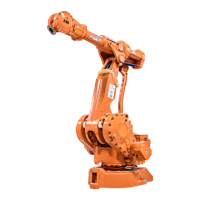Description
10 Product Specification IRB 4400 M98A/BaseWare OS 3.2
2.5 Programming
Programming the robot involves choosing instructions and arguments from lists of
appropriate alternatives. Users do not need to remember the format of instructions,
since they are prompted in plain English. “See and pick” is used instead of “remember
and type”.
The programming environment can be easily customised using the teach pendant.
- Shop floor language can be used to name programs, signals, counters, etc.
- New instructions can be easily written.
- The most common instructions can be collected in easy-to-use pick lists.
- Positions, registers, tool data, or other data, can be created.
Programs, parts of programs and any modifications can be tested immediately without
having to translate the program.
The program is stored as a normal PC text file, which means that it can be edited using
a standard PC.
Movements
A sequence of movements is programmed as a number of partial movements between
the positions to which you want the robot to move.
The end position of a movement is selected either by manually jogging the robot to the
desired position with the joystick, or by referring to a previously defined position.
The exact position can be defined (see Figure 6) as:
- a stop point, i.e. the robot reaches the programmed position
or
- a fly-by point, i.e. the robot passes close to the programmed position. The size
of the deviation is defined independently for the TCP, the tool orientation and
the external axes.
Figure 6 The fly-by point reduces the cycle time since the robot does not have to stop at
the programmed point. The path is speed independent.
The velocity may be specified in the following units:
- mm/s
- seconds (time it takes to reach the next programmed position)
- degrees/s (for reorientation of the tool or for rotation of an external axis).
Stop point
Fly-by point
User-definable distance (in mm)

